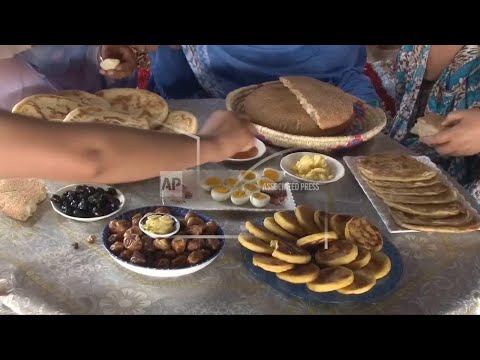(24 May 2025)
MOROCCO UNESCO FOOD
SOURCE: ASSOCIATED PRESS
RESTRICTIONS:
LENGTH: 6:32
ASSOCIATED PRESS –
Rabat, Morocco – 8 May 2025
1. Close up of sweet pumpkin paste being decorated with roasted flaked almonds, containing pumpkin, honey, cinnamon, butter and orange flower water
2. Wide of a chef in the kitchen of traditional restaurant "Zyriab" decorating the sweet pumpkin paste
3. Close up of "Moroccan Salad", containing tomato, cucumber, onion and parsley cut into small cubes and decorated with oil-cured black olive
4. Various of the chef continuing to decorate the hot and cold appetizers
5. SOUNDBITE (Arabic) Amine El Boujadi, Head Chef, Zyriab, traditional restaurant:
"Moroccan cuisine represents the culture and identity of Morocco. It is also known for its diversity, according to the variety of the regions. Each city is known for its dish, for example, bastilla from Fez, tanjia from Marrakech which is cooked in clay, and beef tagine with prunes and caramelized apricots from Rabat. Moroccan cuisine is also characterized by its nutritional balance."
6. Wide of restaurant waiters serving hot and cold appetizers to customer sitting next to El Boujadi
7. Hot and cold appetizers being served
8. Various of customer tasting an appetizer
9. Pan of waiter serving the Moroccan chicken olive lemon tagine
10. Mid of chicken olive lemon tagine
11. SOUNDBITE (Arabic) Amine El Boujadi, Head Chef, Zyriab:
"A variety of spices and herbs, such as pure saffron, turmeric, and black pepper, are used in Moroccan dishes. However, despite the importance of these ingredients, Moroccan cuisine depends heavily on the skills of the Moroccan cook, as it relies on a set of techniques that help give each dish its unique flavour."
ASSOCIATED PRESS –
Brachoua, Morocco – 6 May 2025
12. Wide of customers sitting under a tent in a food cooperative in Brachoua village, 50 Km from Rabat, having a traditional breakfast, next to a man filling cups with Moroccan mint tea
13. Close up of a cup being filled with tea
14. Customers drinking tea
15. Mid of breakfast table containing traditional bread, "meloui, harcha and batbout" Moroccan pancakes, honey, dates, oil-cured black olive, organic eggs and natural butter
16. Mid of Aicha Sellahi, president of the association "Ahl Al-Sahra for Development" in Brachoua village, eating
17. SOUNDBITE (Arabic) Aicha Sellahi, president of the association "Ahl Al-Sahra for Development" in Brachoua village:
"The Moroccan breakfast table consists of natural and traditional ingredients such as tea, Moroccan pancake (msemmen, harcha, batbout), natural butter, pure honey, and bread that is baked in a traditional oven."
18. Pan of Naima El Meziane, president of the food cooperative "Golden Sands", making small holes in the traditional bread and putting it in the wood traditional oven
19. Mid of bread inside the wood traditional oven
20. Wide of Naima taking cooked bread from the oven
21. Close up of cooked bread
22. SOUNDBITE (Arabic) Naima El Meziane, president of the food cooperative "Golden Sands" in Brachoua village:
"When we knead the bread, we add natural yeast and use wheat and barley flour, which are rich in fibers. This is what distinguishes traditional bread from the bread sold in bakeries, it is healthier due to the fibers and natural yeast."
23. Wide of Laila El Harmaoui, a cook, starting the preparation of rfissa, she puts first the organic chicken and then adds onion cut into wedges
24. Mid of lentils and fenugreek seeds being put in the pressure cooker already filled with the organic chicken and onion cut into wedges
Find out more about AP Archive: http://www.aparchive.com/HowWeWork
Twitter: https://twitter.com/AP_Archive
Facebook: https://www.facebook.com/APArchives
Instagram: https://www.instagram.com/APNews/
You can license this story through AP Archive: http://www.aparchive.com/metadata/youtube/a1d6ebf163bc47f3b900a4efbf82c347
Author: AP Archive
Go to Source
News post in May 29, 2025, 3:05 am.
Visit Our Sponsor’s:
News Post In – News





